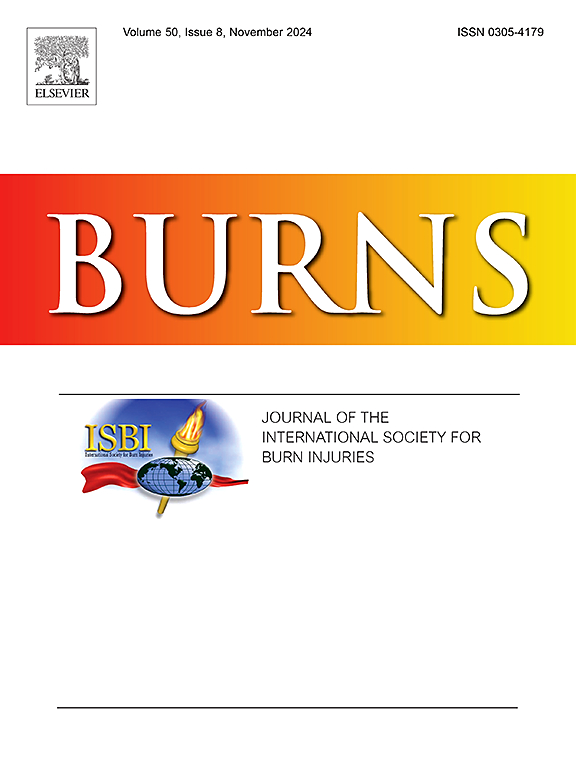Do paediatric patients with suspected non-accidental burn injuries have worse clinical outcomes? A 5-year retrospective review from a UK burns centre
IF 3.2
3区 医学
Q2 CRITICAL CARE MEDICINE
引用次数: 0
Abstract
Background
Burns are a very common reason for attendance and admission of children to hospital. Non-accidental injury (NAI) and child protection concerns (CP) are crucially important in paediatric burns presentations – prevalence in the UK is reported between 5 % and 14 %. This range reflects challenges in identifying suspicious injuries, as well as the underlying geographic and socioeconomic variations in practice.
Aims
This study examines the demographics, management, and outcomes of paediatric burns admissions with NAI or CP concerns in a UK burns centre.
Methods
Retrospective analysis of all acute paediatric burns and thermal injury patients admitted at the Royal Hospital for Children, Glasgow 2018–2022 inclusive.
Results
594 eligible patients were identified, with a mean age of 4.67 years, a mean % total body surface area burn (%TBSA) of 3.65 % and scald burns being the most common mechanism (59.3 %). The majority of patients (84.2 %) were managed conservatively.
94 (15.8 %) patients had concerns relating to CP issues or potential NAI during their admission. These patients were more likely to have larger %TBSA injuries (P < 0.001), to have a longer duration of admission (P < 0.001) and to be from a more socioeconomically disadvantaged background (P = 0.007). There was no statistically significant difference in mean age, need for surgery, positive microbiology, antibiotic use and duration of follow up.
Discussion
The prevalence of NAI/CP concerns in our series was higher than the UK mean, possibly reflecting socioeconomic disparities. Suspected NAI cases were not associated with worse clinical outcomes.
We recommend that individual burn services examine their own patient cohorts to determine NAI prevalence and interpret these findings in the context of their geography and socioeconomic composition. A primary focus of teams treating paediatric burn patients should be on prompt recognition of suspicious injuries, escalation through local safeguarding channels, and influencing public health prevention policies, where applicable.
疑似非意外烧伤的儿科患者是否有更差的临床结果?英国烧伤中心5年回顾性研究
背景烧伤是儿童住院和住院的一个非常常见的原因。非意外伤害(NAI)和儿童保护问题(CP)在儿科烧伤表现中至关重要-据报道,英国的患病率在5 %和14 %之间。这一范围反映了识别可疑伤害的挑战,以及实践中潜在的地理和社会经济差异。目的:本研究探讨了英国烧伤中心因NAI或CP引起的儿科烧伤入院的人口统计学、管理和结果。方法回顾性分析2018-2022年格拉斯哥皇家儿童医院收治的所有急性儿科烧伤和热损伤患者。结果594例符合条件的患者,平均年龄4.67岁,平均体表烧伤% (%TBSA)为3.65 %,烫伤烧伤是最常见的机制(59.3 %)。大多数患者(84.2 %)采用保守治疗(15.8 %)患者在入院时担心CP问题或潜在的NAI。这些患者更有可能有较大的TBSA损伤(P <; 0.001),更长的入院时间(P <; 0.001),以及来自更不利的社会经济背景(P = 0.007)。两组患者的平均年龄、手术需求、微生物学阳性反应、抗生素使用和随访时间差异无统计学意义。在我们的研究中,NAI/CP的患病率高于英国的平均水平,这可能反映了社会经济差异。疑似NAI病例与较差的临床结果无关。我们建议各个烧伤服务部门检查他们自己的患者队列,以确定NAI的患病率,并在其地理和社会经济组成的背景下解释这些发现。治疗儿科烧伤患者的小组的主要重点应是迅速识别可疑损伤,通过当地保障渠道进行升级,并在适用的情况下影响公共卫生预防政策。
本文章由计算机程序翻译,如有差异,请以英文原文为准。
求助全文
约1分钟内获得全文
求助全文
来源期刊

Burns
医学-皮肤病学
CiteScore
4.50
自引率
18.50%
发文量
304
审稿时长
72 days
期刊介绍:
Burns aims to foster the exchange of information among all engaged in preventing and treating the effects of burns. The journal focuses on clinical, scientific and social aspects of these injuries and covers the prevention of the injury, the epidemiology of such injuries and all aspects of treatment including development of new techniques and technologies and verification of existing ones. Regular features include clinical and scientific papers, state of the art reviews and descriptions of burn-care in practice.
Topics covered by Burns include: the effects of smoke on man and animals, their tissues and cells; the responses to and treatment of patients and animals with chemical injuries to the skin; the biological and clinical effects of cold injuries; surgical techniques which are, or may be relevant to the treatment of burned patients during the acute or reconstructive phase following injury; well controlled laboratory studies of the effectiveness of anti-microbial agents on infection and new materials on scarring and healing; inflammatory responses to injury, effectiveness of related agents and other compounds used to modify the physiological and cellular responses to the injury; experimental studies of burns and the outcome of burn wound healing; regenerative medicine concerning the skin.
 求助内容:
求助内容: 应助结果提醒方式:
应助结果提醒方式:


